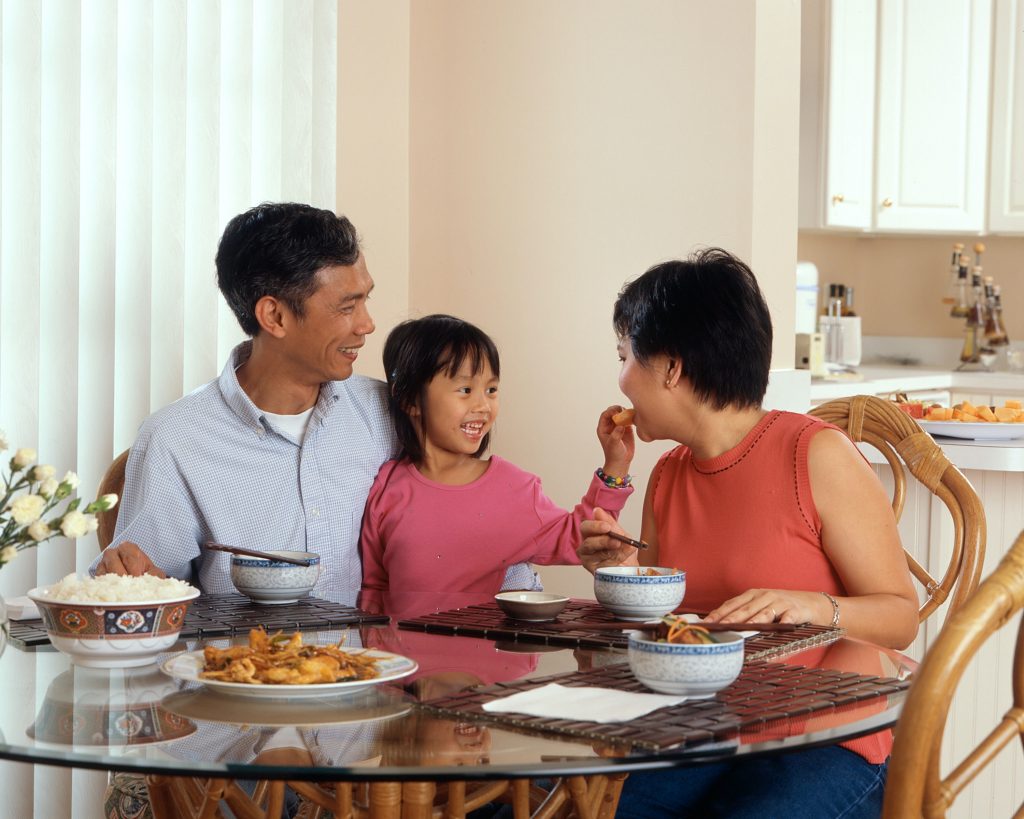One thing that has been well established in the literature is that children absorb everything they see and hear their parents say and do. As such, this puts a large amount of responsibility on parents to model positive behaviour to their children, especially when it comes to eating.
Whilst this may seem daunting, all it takes is being mindful about how you behave around food. Here’s a few points to consider:
- Eat the same food you serve your children
- Avoid eating ‘diet’ products around your children or discussing food in a negative way (e.g “I can’t eat bread, the carbs make me gain weight!”)
- Model routine and structure (e.g we eat breakfast, then morning tea, lunch, so on so forth)

While these points are merely suggestions, it has been well discovered through research that these behaviours encourage children to feel that the food they eat is safe, enjoyable, and yummy! It also enables them to feel free to eat whatever food they are given without concerns about if it is ‘bad’ or ‘good’ for them. Modelling routine is especially important for children to see how food is consumed in the house, it enables them to feel comfortable and know what is going to happening next (e.g after dinner is wash up, then brush teeth etc..). Furthermore, it also supports regular appetite as they begin to learn the sensation of fullness and hunger.
Side note: hunger is not a bad thing! It is a normal thing to feel and does not need to be averted at all times. Having a mealtime routine enables children to learn that although they may get hungry it will not harm them and hunger does not mean food is scarce.
Division of Responsibility
It extremely important to note that force feeding children is a negative approach to nutritional intake and over time can build resistance to change, fear of foods, and poor dietary behaviours later on in life2. The ‘division of responsibility’ approach was developed by an expert in the field of paediatric nutrition and feeding, Ellyn Satter. This approach acknowledges that both the child and parent are responsible for mealtimes and feeding.

Development of healthy eating habits can be achieved through time and patience with your child. It is important to offer a both variety and repetition to increase your child’s food acceptability and tolerance. Even if a food is rejected, offer it another day, and another and another, sometimes it can take up to 15 times of repeatedly offering a ‘new’ food until they will accept it3. Patience is key! Remember to trust them as well; it is okay if they don’t eat at one meal, they will eat at the next.
Preparing Family Meal Time
Making family mealtimes a regular routine can support children to understand that food doesn’t have a sole purpose of filling their stomachs, but facilitates time spent with family to talk and enjoy each other’s company.
A regular pattern to meal times may look like:
- Setting the table
- Serving meals/placing meals on table
- Eating time for 15-20 minutes (main meals), or 10-15 minutes (snacks)
- Collect plates
- Wash up
This pattern helps children learn that meals are eaten at the table, as a family, and whatever you don’t eat gets taken away at the end/leftovers/thrown out. This routine can be comforting for children to know and understand so that they do not feel threatened by food being placed in front of them or the idea that mealtimes are endless/end when all food is gone.
Family style serving is one strategy that can be used to help children feel comfortable and unthreatened at mealtimes. It may be particularly helpful for those with limited food acceptance. This style of family mealtime enables the children to serve themselves the food that has been prepared (as shown in the below picture). In this style of family mealtime parental role modelling is particularly important in demonstrating to the children how to serve themselves, and that all the food is good to eat.

Another beneficial family mealtime practice is allowing children to participate in meal preparation. This can help them to become familiar with different foods and how it is made.
Shopping, putting chopped food in a bowl, mixing foods, stirring, are all ways to immerse children in the mealtime preparation experience and has been shown to having many positive mental health benefits for both child and parent4.
Nurturing your child to develop a positive relationship with food and enjoy mealtimes can be an enjoyable, adventurous, and a valuable experience for both parent and child. Although there is a great deal of information on the internet and social media, don’t get overwhelmed! Practicing some of the tips and tricks mentioned here is a great way to start. Being calm and open minded with your children around mealtimes can be one of the best ways to support them to feel comfortable with trying new foods and develop positive behaviours which will last a lifetime.
Reference List
- Bennett C, Copello A, Jones C, Blissett J. Children overcoming picky eating (COPE) – A cluster randomised controlled trial. Appetite. 2020 Nov 1;154:104791. doi: 10.1016/j.appet.2020.104791. Epub 2020 Jul 10. PMID: 32659247.
- Georgia Middleton, Rebecca Golley, Karen Patterson, Fairley Le Moal, John Coveney. What can families gain from the family meal? A mixed-papers systematic review, Appetite- Volume 153, 2020, 104725, ISSN 0195-6663. https://doi.org/10.1016/j.appet.2020.104725
- Dallacker M, Hertwig R, Mata J. Quality matters: A meta-analysis on components of healthy family meals. Health Psychol. 2019 Dec;38(12):1137-1149. doi: 10.1037/hea0000801. Epub 2019 Sep 26. PMID: 31556657.
- Wolstenholme, H., Kelly, C., Hennessy, M. et al. Childhood fussy/picky eating behaviours: a systematic review and synthesis of qualitative studies. Int J Behav Nutr Phys Act 17, 2 (2020). https://doi.org/10.1186/s12966-019-0899-x

